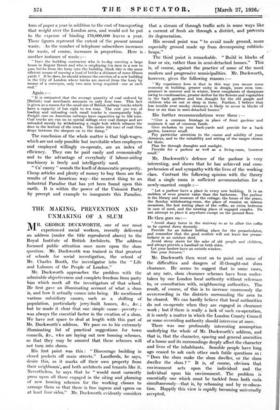THE MAKING, PREVENTION AND UNMAKING OF A SLUM
MR. GEORGE DUCKWORTH, one of our most experienced social workers, recently delivered an address (under the title reproduced above) to the. Royal Institute of British Architects. The address focussed public attention once more upon the slum question. Mr. Duckworth was trained in that greatest of schools for social investigation, the school of Mr. Charles Booth, the investigator into the " Life and Labours of the People of London."
Mr. Duckworth approaches the problem with the admirable objectiveness and complete freedom from party bias which mark all the investigators of that school. He first gave an illuminating account of what a slum is, and how it actually comes into being. He mentioned various subsidiary causes, such as a shifting of population, particularly jerry-built houses, &c., &c. ; but he made it clear that one simple cause—poverty- was always the essential factor in the creation of a slum. We have not space to deal at length with this part of Mr. Duckworth's address. We pass on to his extremely illuminating list of practical suggestions for town councils, &c., aio are laying out new housing schemes, so that they may be assured that these schemes will not turn into slums.
His first point was this : " Discourage building in closed pockets off main streets." Landlords, he says, desire this, as it marks off their own property from their neighbours', and both architects and tenants like it. Nevertheless, he says that he " would most earnestly press upon all those engaged in the siting and planning of new housing schemes for the -working classes to arrange them so that there is free ingress and egress on at least four sides." Mr. Duckworth evidently considers that a stream .of through traffic acts in some ways like a current of fresh -air through a district, and prevents its degeneration. His second point was " to avoid made ground, more especially ground made up from decomposing rubbish- heaps." The third point is remarkable. " Build in blocks of four or six, rather than in semi-detached houses." This is, of course, against the practice of some of the most modern and progressive municipalities. Mr. Duckworth,, however, gives the following reasons :-- " My experience here is that in this way you secure some economy in building, greater unity in design, more even tem- perature in summer and in winter, fewer complaints of dampness owing to condensation, greater shelter for the flowers and vegetables in the back gardens and less draught for the old people and children who sit out or sleep in them. Further, I believe that less trouble over smoky chimneys is likely to occur in blocks of four or six than in semi-detached houses."
His further recommendations were these :- " Give a common frontage in place of front gardens and maintain it out of common funds.
Give seclusion to your back-yards and provide for a back garden, however small.
Pay particular attention to the course and solidity of your chimneys, and to the suitability and setting of the ranges chosen for them.
Plan for through draughts and sunlight.
Provide' for a parlour as well as a living-room, however small."
Mr. Duckworth's defence of the parlour is very interesting, and shows that he has' achieved real com prehension of and sympathy with the lives of the working class. Contrast the following opinion with the theory that a single room is sufficient accommodation for a newly-married couple :— " Let a parlour have a place in every new building. It is an emblem of even greater value than the bathroom. The parlour is the library and museum of the cottage, the home of the piano, the Sunday withdrawing-room, the place of reunion on solemn occasions, the last resting place of the coffin, an extra bedroom in ease of need, and the meeting place of engaged couples. Do
not attempt to place it anywhere except on the ground floor. •
He then goes on " Avoid sharp turns in the stairway so as to allow the coffin to be carried down decently.
Provide for an indoor holding place for the perambulator, and remember that the good mother will not leave her peram- bulator in an outdoor shed.
Avoid steep stairs for the sake of old people and children, and always provide a handrail on both sides. • Let your larders have an outside window. Site your fixtures."
Mr. Duckworth then went on to point out some ,of the difficulties and dangers of ill-thought-out slum clearance. He seems to suggest that in some cases,• at any rate, shim clearance schemes have been under-. taken by one London local authority without reference to, or consultation with, neighbouring authorities. The result, of course, of this is to increase enormously the overcrowding in the districts surrounding the area to. be cleared. We can hardly believe that local authorities do not co-operate when they are engaged in clearance work ; but if there is really a lack of such co-operation, it is surely a matter in which the London County Council or some overriding authority should intervene at once. There was one profoundly interesting assumption underlying the whole of Mr. Duckworth's address, and that is, that the character, spacing and general amenities of a house and its surroundings deeply affect the character and lives of the inhabitants. Sensible people have long, ago ceased to ask each other such futile questions as ; " Does the slum make the slum dweller, or the slum dweller the slum ? " It is, of course, obvious that environment acts upon the individual and the individual upon his environment. The problem is essentially one which must be tackled from both ends- simultaneously—that is, by rehousing and by re-educa-. tion. Happily this view is rapidly becoming universally accepted,






















































 Previous page
Previous page